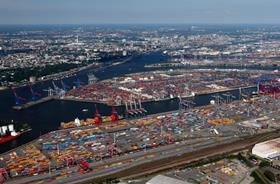
At 70.8m tonnes, Hamburg’s first half (H1) seaborne cargo throughput was just below the previous year’s total.
For the first six months of the year bulk cargo handling stood at 23.6m tonnes, 12.3 per cent up on the previous year. First-half container throughput reached 4.5m TEUs, 6.8 per cent below the 2014 H1 total.
The downturn in cargoes to/from China and Russia hit container handling at Germany’s largest port especially hard. A large part of the cargo for/from China and Russia is transhipped via Hamburg, being transferred from large containerships on to feederships, or vice versa.
“In the first half of 2015 China’s total foreign trade shrank noticeably, by 6.9 per cent. The weak trend in foreign trade was especially apparent in exports from China to Europe on account of the costlier yuan. During the first six months of the years the euro was on average 19 per cent lower than the yuan, making purchase of Chinese goods costlier for European importers,” explained Axel Mattern, CEO of Port of Hamburg Marketing.
On container traffic with Russia, in addition to the trade sanctions still in force, other factors such as the weak rouble, the fall in the oil price and economic recession have also caused the distinct downturn in container throughput at Hamburg.
For 2015 the Port of Hamburg’s marketing organisation expects there to be a further increase in bulk cargo handling and a slight overall downturn in container throughput. By the end of the year, seaborne cargo throughput of 141m tonnes, including 9m TEU, is possible. For this to happen, it is 'essential' that seaborne foreign trade with core markets should become stable, the organisation added.






No comments yet